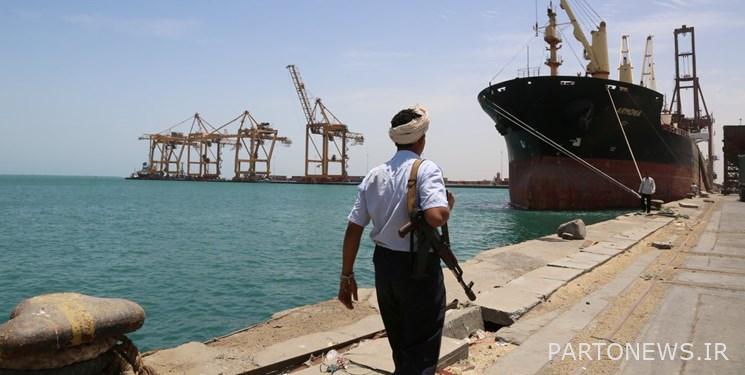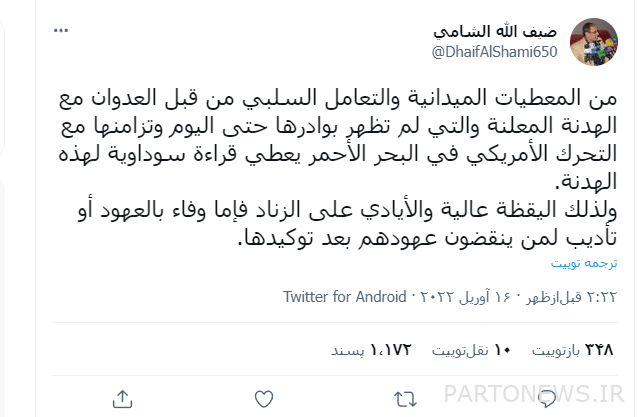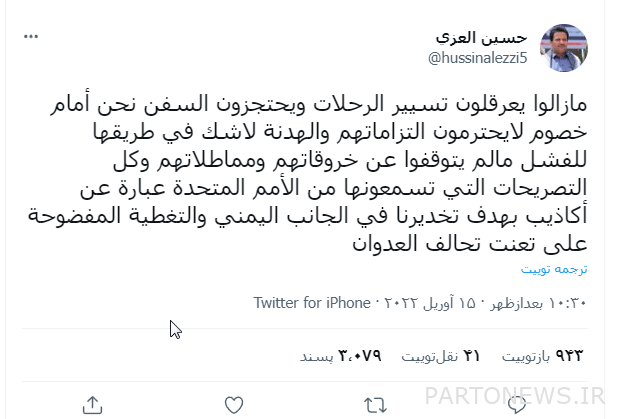Sabotage of the Saudi coalition and concerns about the failure of the ceasefire in Yemen

According to Fars News Agency’s International Service, after a quarter of a two-month ceasefire in Yemen, the Saudi coalition has evaded its main obligations, especially the lifting of the siege of Sanaa Airport, and has continued to seize three Yemeni oil ships; However, these ships are licensed by the United Nations.
Simultaneously with these promises, the United States has deployed its navy in the Red Sea, which is contrary to the spirit of the ceasefire agreement. In this regard, Mohammed Abdul Salam, spokesman for the Ansarullah movement and head of the negotiating team of the Yemeni National Salvation Government (based in Sanaa), described the large US military presence in Yemeni waters as contradicting Washington’s claim of supporting the ceasefire and trying to lift the siege. explained.
On Wednesday, the US Navy announced that it had formed new units of the US military to conduct military courses and exercises in the Red Sea.
Brad Cooper, commander of the US Fifth Fleet in the Middle East, told reporters that the units had been formed and said: “Joint forces will see the USS Mount Whitney join the US Fifth Fleet in the Middle East; “The ship was previously in the possession of Washington’s Sixth Fleet in Africa and Europe.”
Following the comments of Sanaa government officials, Abdul Malik al-Ajri, a member of the Sanaa negotiating team, said that the Saudi coalition was not constructive in the face of the ceasefire and that the UN had acted contrary to expectations.
He wrote on his Twitter page that for Sanaa, the ceasefire is an opportunity to put the wheel of peace on the rails, but the response and actions of the aggressor countries do not lead to optimism about the future of the ceasefire.

Zaifullah al-Shami, a spokesman for the Yemeni National Salvation Government, also said that there were no signs of a ceasefire to date, and that it coincided with US movements in the Red Sea, giving a dark reading of the ceasefire.
He added: “He is very alert and his hands are on the trigger; “So either keep your promise or discipline those who break it.”

Sanaa Deputy Foreign Minister Hussein al-Azzi also denied the UN allegations, saying they were intended to deceive Sanaa and cover up the Saudi coalition’s oppression. He stressed that the countries invading Yemen continue to block flights from Sanaa airport and ships.
“We are facing enemies who do not live up to their promises, and as long as they do not break their promises and sabotage, firearms are undoubtedly on the verge of defeat,” he stressed.

Meanwhile, Essam Al-Mutawakil, a spokesman for the Yemeni Oil Company, said that the Saudi coalition was still detaining three ships carrying Yemeni oil derivatives despite receiving UN permits.
He told Sabant News Agency that the Saudi coalition continued its piracy and yesterday seized the oil tanker Harvest, which was carrying 29,976 tons of diesel, and prevented it from moving to the port of Al-Hudaidah. The ship was inspected by the United Nations off the coast of Djibouti and received a passage permit.
In addition to the diesel carrier, two other gasoline carriers are still in the custody of the Saudi coalition, containing a total of 88,439 tonnes of diesel and gasoline. These ships are mainly transported to the port of Jazan in southwestern Saudi Arabia.
The seizure of fuel imported to Yemen comes at a time when clinics and hospitals are in dire need of it to continue operating, as well as diesel vehicles to transport food to the fuel, and therefore the seizure of these ships directly increases mortality as well as increasing shortages. Food has a direct impact on Yemen.
Prior to accepting the ceasefire, the military and political officials of the Sanaa government had repeatedly stated that any ceasefire that did not include lifting the siege of Yemen was of no value and was considered a continuation of the aggression.
Violation of firearms on the battlefield
As for the role of firearms in the field, military sources told Yemen’s Sabant news agency that the Saudi coalition and Riyadh-affiliated militias had committed 55 ceasefire violations in the past 24 hours.
According to these sources, 45 cases are related to the flight of reconnaissance and operational drones in the skies of Ma’rib, Al-Jawf, Hajjah, Saada, Al-Hudaidah, Al-Bayda, Imran, Al-Mahwit and border areas.
Riyadh-affiliated militias also fired four Katyushas at Yemeni army positions and popular committees in al-Akkad, al-Naqa’a and Balq al-Sharqi districts in Ma’rib province. Saudi coalition artillery also fired twice at positions of Sanaa government forces in Ma’rib.
In the provinces of Ma’rib, al-Dhala, and al-Jawf, civilian homes and positions of the army and popular committees were shelled eight times by Saudi coalition militants.
In Al-Hudaidah province, where the cases of fire-fighting violations are documented separately according to the Stockholm Agreement of Sweden (2018), 124 fire-fighting cases have been committed in the last 24 hours. Of this amount, 23 were related to artillery attacks and 88 were to civilian shootings and positions of the army and popular committees, and the rest included the flight of spy and operational drones.
End of message / m
You can edit this post
Suggest this for the front page

